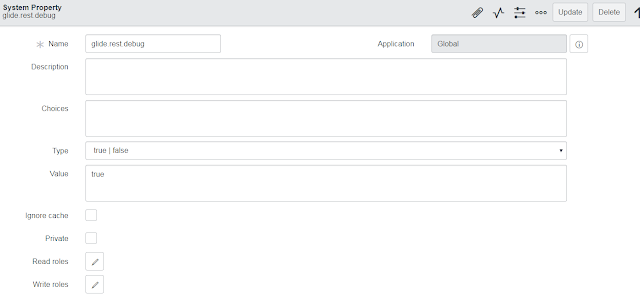1. Make
sure the property “glide.rest.debug”
is set to true under sys_properties table.

2. Get the REST request URL and the user_id of the user with which the REST call is coming to instance.
REST Request
URL à https://******.service-now.com/api/now/table/incident
userid à mychartintegration
3. Log onto instance and navigate to the Transactions under System Logs.
Search for the user_id in created by
field and REST request URL in URL field (eg. for REST URL -
https://nychhcdev.service-now.com/api/now/table/incident look for "/api/now/table/incident"
in the URL field of transaction logs)
4. Note
the Ticket created time for which ticket you are facing issue and open that particular
transaction log from transactions above.
Ticket created à
12/04/2018 11:07:25
5. Find the transaction from above and note the value in System
ID (node name) and Session ID fields of the identified transaction.
If you don’t find system ID, configure
Form layout and add the field on the form.
System id à *************************
Session ID à *************************
6.
Navigate to the stats page to find the node you are logged in. (Check 2nd line
on the page which says - Connected to cluster node and note the node name)
https://nychhcdev.service-now.com/stats.do
Cluster node à *****************************
7. If Cluster node and System ID are
same from 5 and 6 steps above:
n Then, it’s easy to debug.
n Open
Node Log File Browser
under System Logs and copy Session ID and Change Start time and End time to
ticket creation time approximately.
n You
will see the Incoming Request Body here with the clear incoming request.
8. If Cluster node and System ID are
different from 5 and 6 steps above:
n Then,
Go to Node Log File
Download under System Logs and download localhost log for the day when
the request was made to the instance.
9) Once you download the correct logs from STEP 8, open with Windows
Wordpad Application and do a "search" on the log file using the Session
ID identified in Step 5.
10) The Session logs which will be obtained from the filtered logs in
step 9 will have the Request body in the logs which is sent to ServiceNow.






No comments:
Post a Comment